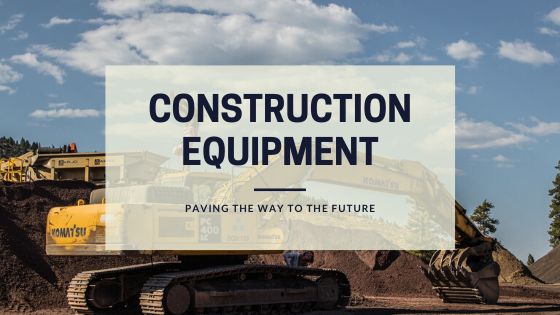
The construction industry is one of those major industries, to which technology has contributed significantly and had a huge impact on, and specially on invention and smooth operation of Construction Equipment.
Whenever we see a construction project in our neighbourhood, we can witness different types of construction equipment and vehicles taking the lead role of the work, starting from the excavation, to the material transportation, in contrast to the 10-15 years earlier state, where we experienced several people working of the field, and there is very less amount of equipment with them.
So I’d like to highlight the necessity of the equipment in our construction industry, types, and procedures available for financing the equipment, through this article.
The Necessity of the Construction Equipment:
The necessity of the construction equipment in our construction industry is undeniable. Having a large and wide range of applications, it has smoothened the works of people, directly involved at the construction site.
The necessity of the construction equipment, in our modern industry, can be judged by the following points:
- Time: The first and foremost necessity is contributed to time and accuracy. By using modern construction equipment, the organization can save a lot of time, which may be again utilized in other aspects of organizational works.
- Money: The second necessity is money. Most of the construction firms, that undertakes several construction works, fixes a margin of profit, which at the end of their activity they’d like to earn. the more economical the process is, the more money they can save serving as their profit, which is why they’ll most likely choose that option. Modern Construction Equipment is that process, which makes the organization save a great amount of money, by shortening the number of people working on the site.
- Safety: The third necessity is Safety. In modern construction, this is a very important aspect to be taken care of. Construction Equipment ensures the labourers’ safety, as they do not have to go down 4-5 meters below in the excavated portion, thus, their mental health also remains undisturbed.
The above three points mentioned in the above are completely interconnected and the impact on one affects the other two. There are other necessities such as the quantity of work etc, but they are also directly connected with the other two.
Scope of Our Labour Force:
Many times, the use of equipment may give rise to the question, that what about the majority of the workforce, they’ll mostly get unemployed, which will result into the economy’s downfall in the country.
Though it might seem true to some extent, we can’t deny this fact that as long as machine exists, maintenance will go on. And in a completely equipment based construction world, people will be hired for maintenance as well as smooth operation of those equipments. On the other hand, the more the organization saves money, the more they’ll contribute to the country’s economy.
Types of Construction Equipments
The types of construction equipment are generally categorized into four, depending on their techniques of operation and purpose. They are as follows:
Earth Moving Vehicles
These are generally intended to excavation purpose to transport earth and soil to a different place from an existing place. Earth Moving Vehicles include
Excavator: Widely used in any construction projects Nowadays. Generally designated to excavate for Mat foundation. It consists of boom, dipper, bucket and can on a rotating platform, named the “house”. It is completely hydraulically operated, and the entire vehicle is mounted on wheels, consisting of stream chains and steel plates.
Trenchers: Mostly used in for making trenches which are less wide to great depth. It is mostly suitable for the installation of drainage pipes, and electrical cables. The size may vary depending upon the quantity of work.
Scrapers: Used for making trenches of great width. It is often considered to be an earthmoving vehicle. It is mainly operated over a short distance, send in relatively smooth areas.
Loaders: Loaders are heavy equipment, which is widely used in move aside construction materials, debris, raw minerals, asphalt etc. There are various types of loaders depending upon the design and applications, such as Bucket loader, front loader, skip loader etc.
Backhoe: Typically mounted on the back of a tractor, this heavy equipment is used for excavation and digging. It consists of a digging bucket.
Construction Vehicles:
They are the vehicles intended for construction works. Some vehicles of these type are:
Dumpers: Mostly used for transportation of materials from storage, to the construction site such as sands, gravels etc, transportation of demolition waste. There are various types which come in various specifications, assigned to complete a specific task.
Trailers: Widely used for transportation of heavy materials. This equipment comes in different sizes and different specifications, depending upon the quantity and nature of work.
Material handling equipment:
These are equipment designated for material handling and transporting from one place to another place in the construction site. These include-
Crane: It is a material handling and transporting equipment, equipped with a hoist rope, wire ropes, chains and sheaves. It is mainly used for lifting heavy things and transporting them to a different place, thus it can be Widely noticed in the high rise construction site, where heavy loads are required to transport vertically to a considerable height.
Conveyors: These are the equipment, which can be Widely seen to the concrete batching plant or RMC plants. Specially used for the purpose of transportation of aggregates. It consists of two pulleys with an endless loop, in which materials are loaded to transport them to a different place.
Pipeline: Most Widely used for the transportation of plastic concrete (Not very stiff). Their size may vary depending upon the size of aggregates used. It is generally assumed that the diameter of the pipeline, is 3-4 times the diameter of the maximum size of the aggregates used in construction. It is very common equipment in the modern construction industry.
Hoists: Also intended to transport construction materials by lifting it and to transport it in a different place. It can be manually operated, electrically or pneumatically driven. It also may use, chain, wires or ropes as lifting medium.
Construction Equipment
This category consists of machines such as,
Concrete Mixer: Can be seen in every construction site. Their types and capacity vary depending upon the type and accuracy of construction. There are mainly two categories of concrete Mixer, Drum type and pan type. The capacity of a concrete mixer depends upon the amount of concrete work. As an example, for concrete work of 1:2:4, a concrete mixer of 280 lit may be fit necessary.
Compactors: Intended to the purpose of Compacting soil, aggregates and concrete. Example: Internal & External Vibrators for the purpose of vibrating Columns and other structural elements. There are also other types of vibrators such as formwork vibrator, table vibrating, screed vibrator(intended to roadway construction). The commonly used vibrator, needle vibrator, is often specified depending upon the diameter of the needle, such as 40mm needle vibrator.
Pavers: Used for finishing works in Road Construction, especially the construction of rigid pavements. It is often used in concrete slab finishing works, where a smooth appearance is needed.
Road Rollers: Used for every Road construction works. It can come in various categories too, depending upon the type and volume of the construction work.
Financing of Construction Equipment
There are various types of financing techniques currently available for renting or buying different construction equipment and vehicles. It is largely dependent upon the buyer’s capacity at hand and the amount of use. If the buyer’s purpose is to frequently use the equipment, then it is better to buy that equipment out, or otherwise renting facility may be available as due to the high cost of modern construction equipment and vehicles. Some financing procedures for renting or buying equipment, are:
- Entering into a financial contract with the owner. This requires down payment of 10-15% of the total cost of the equipment, and the rest is paid via monthly instalments.
- Financing through a commercial corporation, purposely created for renting out the equipment.
- The loan from bank. 75% of the cost of equipment is financed by the bank, and the rest by the purchaser. The number of years for the repayment of the loan, depends upon the category of equipment, I.e. heavy duty, medium duty or light duty
And for excessive use, it is better to buy the equipment, as the cost of renting is quite good, and it’ll be of loss to the contractor or purchaser if it frequently rented out.
Also Read: Modern Methods of Construction

